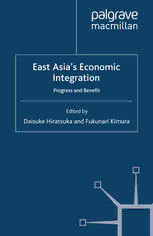
East Asia’s Economic Integration: Progress and Benefit PDF
Preview East Asia’s Economic Integration: Progress and Benefit
East Asia’s Economic Integration Progress and Benefit Edited by Daisuke Hiratsuka and Fukunari Kimura East Asia’s Economic Integration OthertitlesfromIDE-JETRO: MarikoWatanabe(editor) RecoveringFinancialSystems ChinaandAsianTransitionEconomies DaisukeHiratsuka(editor) EastAsia’sDeFactoEconomicIntegration HisayukiMitsuo(editor) NewDevelopmentsoftheExchangeRateRegimesinDevelopingCountries TadayoshiTeraoandKenjiOtsuka(editors) DevelopmentofEnvironmentalPolicyinJapanandAsianCountries MasahisaFujita(editor) RegionalIntegrationinEastAsia FromtheViewpointofSpatialEconomics AkifumiKuchikiandMasatsuguTsuji(editors) IndustrialClustersinAsia AnalysesofTheirCompetitionandCooperation MayumiMurayama(editor) GenderandDevelopment TheJapaneseExperienceinComparativePerspective NobuhiroOkamotoandTakeoIhara(editors) SpatialStructureandRegionalDevelopmentinChina AnInterregionalInput-OutputApproach AkifumiKuchikiandMasatsuguTsuji(editors) TheFlowchartApproachtoIndustrialClusterPolicy MasahisaFujita(editor) EconomicIntegrationinAsiaandIndia East Asia’s Economic Integration Progress and Benefit Edited by Daisuke Hiratsuka and Fukunari Kimura ªInstituteofDevelopingEconomies(IDE),JETRO2008 Softcover reprint of the hardcover 1st edition 2008 978-0-230-55362-0 Allrightsreserved.Noreproduction,copyortransmissionofthispublication maybemadewithoutwrittenpermission. Noportionofthispublicationmaybereproduced,copiedortransmitted savewithwrittenpermissionorinaccordancewiththeprovisionsofthe Copyright,DesignsandPatentsAct1988,orunderthetermsofanylicence permittinglimitedcopyingissuedbytheCopyrightLicensingAgency, SaffronHouse,6-10KirbyStreet,LondonEC1N8TS. Anypersonwhodoesanyunauthorizedactinrelationtothispublication maybeliabletocriminalprosecutionandcivilclaimsfordamages. Theauthorshaveassertedtheirrightstobeidentifiedastheauthorsofthis workinaccordancewiththeCopyright,DesignsandPatentsAct1988. Firstpublished2008by PALGRAVEMACMILLAN PalgraveMacmillanintheUKisanimprintofMacmillanPublishersLimited, registeredinEngland,companynumber785998,ofHoundmills,Basingstoke, HampshireRG216XS. PalgraveMacmillanintheUSisadivisionofStMartin’sPressLLC,175Fifth Avenue,NewYork,NY10010. PalgraveMacmillanistheglobalacademicimprintoftheabovecompanies andhascompaniesandrepresentativesthroughouttheworld. Palgrave(cid:2)andMacmillan(cid:2)areregisteredtrademarksintheUnitedStates, theUnitedKingdom,Europeandothercountries. ISBN 978-1-349-36345-2 ISBN 978-0-230-22730-9 (eBook) DOI10.1057/9780230227309 Thisbookisprintedonpapersuitableforrecyclingandmadefromfully managedandsustainedforestsources.Logging,pulpingandmanufacturing processesareexpectedtoconformtotheenvironmentalregulationsofthe countryoforigin. AcataloguerecordforthisbookisavailablefromtheBritishLibrary. AcatalogrecordforthisbookisavailablefromtheLibraryofCongress. 10 9 8 7 6 5 4 3 2 1 17 16 15 14 13 12 11 10 09 08 Contents ListofFigures ix ListofTables xii NotesontheContributors xv Preface xvi 1 FromDeFactotoDeJureEconomicIntegrationin EastAsia:Past,PresentandFuture 1 DaisukeHiratsukaandFukunariKimura 1.1 Introduction 1 1.2 Defactoeconomicintegration 3 1.3 TheproblemsofdejureintegrationinEastAsia 6 1.4 Evolutionofacore–peripherystructure 11 1.5 GrowingindigenousenterpriseswithMNEs 13 1.6 Benefitfromeconomicintegration 14 1.7 Policyimplicationsofindividualchapters 16 1.8 Conclusion 22 PartI:TheMakingofEconomicIntegrationinEastAsia 27 2 TheModalityofEastAsia’sEconomicIntegration 29 FukunariKimura 2.1 Formingabasicarchitectureofeconomicintegration 29 2.2 DefactoanddejureeconomicintegrationinEastAsia 30 2.3 Dejureeconomicintegrationintermsoftradeingoods 32 2.4 Dejureeconomicintegrationintermsofpolicy measuresotherthantariffs 36 2.5 Geographicalboundaryofdejureplurilateralintegration 38 2.6 Concludingremarks 40 3 TheEastAsianNoodleBowlSyndrome 45 RichardE.Baldwin 3.1 Introduction 45 3.2 Currentstateofplay 47 v vi Contents 3.3 Fragilityandemergingtensions 64 3.4 NewEastAsianRegionalManagementEffort(NEARME) 72 3.5 Concludingremarks 78 4 RulesofOrigin,LocalContentandCumulativeLocal ContentinEastAsia:ApplicationofanInternational Input–OutputAnalysis 82 IkuoKuroiwa 4.1 Introduction 82 4.2 Rulesoforigin 83 4.3 Calculationoflocalcontent 85 4.4 Empiricalresults 89 4.5 Sectoranalysis 101 4.6 Conclusion 109 5 MakingSenseoftheTimelinessofTransportation inEconomicIntegration 118 NobuakiHamaguchi 5.1 Introduction 118 5.2 Developmentoftimelytransportationand revealedgeographicaladvantage 122 5.3 ThetimelinessissueinJapanesetradeinEastAsia 124 5.4 Concludingremarks 137 PartII:TheEvolutionoftheCore–PeripheryStructure 141 6 TheEvolutionofCore–PeripheryStructureinEastAsia 143 NobuakiHamaguchi 6.1 Introduction 143 6.2 Theperspectiveofneweconomicgeographyanalysisfor regionalintegration 144 6.3 RegionalintegrationinEastAsia 148 6.4 PerspectiveoftheeconomicintegrationinEastAsia 158 7 IndustrializationthroughVerticalProductionNetworks: CanLaosParticipate? 162 DaisukeHiratsuka,SouknilanhKeolaandMotoyoshiSuzuki 7.1 Introduction 162 7.2 Industrializationthroughverticalproductionnetworks 164 Contents vii 7.3 Transportcosts 166 7.4 Potentialofindustrializationthroughvertical productionnetworksinLaos 168 7.5 Highfixedcostandborder-relatedbarriersinLaos 170 7.6 Casestudyofhighborder-relatedcostsinLaos andtheireffectonitsparticipationinvertical productionnetworks 172 7.7 Summaryandconclusion 179 8 StructuralChangeinIntermediate,Consumptionand CapitalGoodsTradeDuringEconomicIntegration: theEUExperience 184 BartLosandJanOosterhaven 8.1 Introduction 184 8.2 EUintegrationandtradeandlocationtheory 186 8.3 EUinter-countryinput–outputtablesandmodel 189 8.4 Earlierinter-countryinput–outputresearchon EUintegration 192 8.5 TrendsinEuropeantrade,1975–95 203 8.6 Summaryandconclusion 215 PartIII:TheCurrentStatusofIndigenousEnterprises 223 9 SpilloversandLinkagesbetweenLocalandForeignPlants 225 KazuhikoYokota 9.1 Introduction 225 9.2 Industrialstructureandlocal–multinational linkagesinThailand 228 9.3 Spilloverandlinkageeffects 231 9.4 Furtherdiscussiononspilloversanddemandlinkage effects,andtradeliberalization 242 9.5 FTAanditsimpactonlocalplants 249 9.6 Conclusion 251 10 DoLocalSuppliersBenefitfromEconomic Integration?EvidencefromOutwardFDIfromASEAN 255 DaisukeHiratsuka 10.1 Introduction 255 10.2 WhatdeterminesoutwardFDI? 257 10.3 PatternofoutwardFDIfromASEAN 262 viii Contents 10.4 Intra-regionalFDIinASEAN 268 10.5 Conclusionandpolicyimplications 277 PartIV:QuantitativeImplicationsofEconomicIntegration 281 11 ComparingBilateralandMultilateralASEAN10þ4 FreeTradeAgreements:PossibleImpactsonMember andNon-memberCountries 283 MichelFouquin 11.1 Introduction 283 11.2 TheopenregionalismconceptandAFTA 284 11.3 Quantitativemodelandpossiblescenario 290 11.4 ASEAN10bilateralFTAswithJapan,China, KoreaandIndia 293 11.5 AnAsiansinglemarket? 305 12 HowWillASEANþ3IntegrationAccelerateInvestment? ACGEAnalysis 321 KenItakura 12.1 Introduction 321 12.2 InvestmenttheoryintheDynamicGTAPmodel 322 12.3 Dataaggregationandsimulationdesign 324 12.4 Simulationresults 328 12.5 Concludingremarks 334 Index 339 List of Figures 2.1 Fragmentation:anillustration 36 3.1 TheEastAsian‘noodlebowl’syndrome 48 3.2 PlacementofJapaneseplantsinEastAsia,1975–2004; emergenceofChina 51 3.3 UnilateraltariffcuttinginPhaseII 56 3.4 Formalunilateralism;reductionsinappliedMFNtariffs 56 3.5 AFTAutilizationrates 58 3.6 Intra-ASEANtradebyHSChapter,2003 59 3.7 Totalmanufacturinggrowth,1990–2002 62 3.8 Anexampleofinterdependencein‘FactoryAsia’ 66 3.9 EastAsianbilateraltradeflowsroundedtonearest1% ofregionalflows 72 4.1(a) Changesinlocalcontent(1990–2000): manufacturingsector 95 4.1(b) Changesinimportcontent(1990–2000): manufacturingsector 95 4.1(c) Impactoftradestructuralchanges(1990–2000): manufacturingsector 96 4.1(d) Impactoftechnologicalstructuralchanges(1990–2000): manufacturingsector 96 4.2(a) Changesinlocalcontent(1990–2000): manufacturingsector 99 4.2(b) Changesinimportcontent(1990–2000): manufacturingsector 99 4.2(c) Impactofvalueaddedcoefficientchanges(1990–2000): manufacturingsector 99 4.2(d) Impactoftradestructuralchanges(1990–2000): manufacturingsector 100 4.2(e) Impactoftechnologicalstructuralchanges(1990–2000): manufacturingsector 100 4.3(a) Changesinlocalcontent(1990–2000):electronicssector 102 4.3(b) Changesinimportcontent(1990–2000):electronics sector 103 4.3(c) Impactoftradestructuralchanges(1990–2000): electronicssector 103 ix
